Ramayana › Pandavas » Ancient origins
Articles and Definitions › Contents
- Ramayana › Who Was
- Pandavas › Who Was
Ancient civilizations › Historical and archaeological sites
Ramayana › Who Was
Definition and Origins
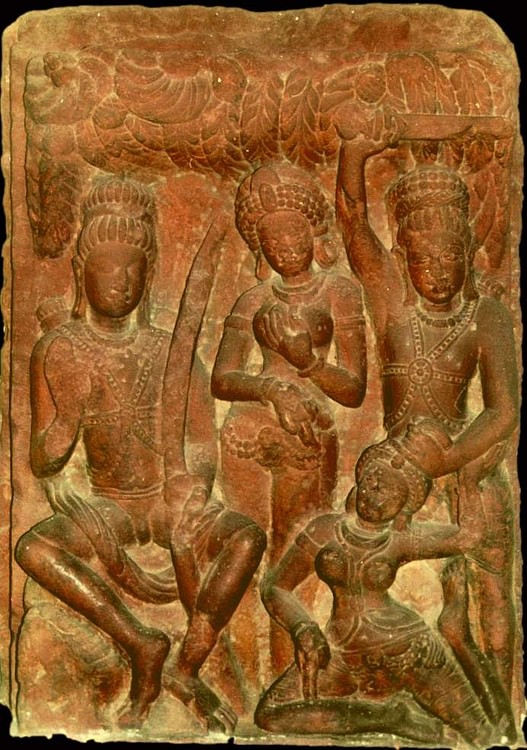
The Ramayana is an ancient Indian epic, composed some time in the 5th century BCE, about the exile and then return of Rama, prince of Ayodhya. It was composed in Sanskrit by the sage Valmiki, who taught it to Rama's sons, the twins Lava and Kush. At about 24000 verses, it is a rather long poem and, by tradition, is known as the Adi Kavya ( adi = original, first; kavya= poem). While the basic story is about palace politics and battles with demon tribes, the narrative is interspersed with philosophy, ethics, and notes on duty. While in that other Indian epic, the Mahabharata, the characters are presented with all their human follies and failings, the Ramayana leans more towards an ideal state of things: Rama is the ideal son and king, Sita the ideal wife, Hanuman the ideal devotee, Lakshman and Bharat the ideal brothers, and even Ravana, the demon villian, is not entirely despicable.
RAMA IS BORN
Dasharath, king of Ayodhya, had no children. So he arranged a Putra-kameshti sacrifice ( putra = son, kameshti = that which is desired). At the sacrifice, Agni (god of fire) arose from the flames and handed the king a golden vase brimming with nectar."Give this to your queens", said the god and disappeared. The king had three wives. To the eldest, the king gave half of the nectar; the second queen got a portion that remained when the queen had drunk her half. To the youngest queen, the king gave the remaining half of the nectar and again, the second queen got the portion that remained. In time, the queens gave birth to sons: to the eldest was born Rama, to the youngest was born Bharat, and to the second queen were born the twins Lakshman and Shatrughna.
RAMA, HERO OF THE RAMAYANA, IS THE IDEAL SON & KING, SITA THE IDEAL WIFE.
RAMA MARRIES SITA
When the princes had grown up some, the sage Vishwamitra arrived at Dasharath's court and asked that Rama and Lakshman be "lent" to him to help him rid his hermitage of the demons that were plaguing the ashram dwellers by defiling their sacrifices with blood and bones, and by killing them off. After the two princes successfully rid the ashram of the demons, the sage took them to the neighbouring kingdom of Mithila to show them the swayamvar festivities of the Mithila princess, Sita, born of the earth. The king of that country had adopted Sita as his daughter and, after Sita had grown up, had declared that he would give her in marriage to anyone who could string the Great Bow of Shiva. No one could. Several kings, princes, and commoners had tried and failed.
The swayamvar had been in progress for several months now and the bow still remained unstrung. It was to this place that the sage Vishwamitra brought the two princes of Ayodhya. Rama and Lakshamn entered the assembly hall where the bow was displayed in all its glory. Rama walked over, picked up the bow, strung it, and plucked the bowstring with such a twang that two things happened simultaneously: the twang was heard for miles around, and the force of it broke the bow into two with so great a sound that the king and his courtiers came running from their chambers to see what the commotion was about. When the confusion had settled, Rama was married to Sita. His three brothers were married to a sister and cousins of Sita, and there were many festivities and much rejoicing in the two kingdoms.
RAMA IS EXILED
Some time later, Dasharath decided he had grown too old to rule and declared he would abdicate in favour of Rama, the eldest born and the crown prince. This is when his youngest queen invoked an old promise that Dasharath had made to her: she demanded that Rama be exiled for 14 years and that her own son, Bharat, be crowned king. Dasharath refused but Rama decided to honour his father's old promise and left for the forests. He was accompanied by Sita and by Lakshman, both of whom could not be dissuaded from following him. In grief at the injustice of it all and at Rama's departure, Dasharath died within two days.
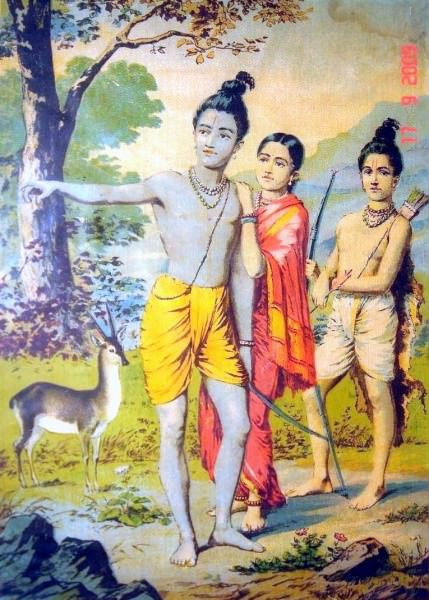
Rama, Sita, & Laksmana
Bharat was not in Ayodhya when these events happened; he, and the fourth prince Shatrughna, were away holidaying at Bharat's maternal grandfather's country. They were summoned to Ayodhya in haste and, when Bharat learnt what had happened, he was furious. He shouted at his mother, refused to ascend the throne, and gathered the townsfolk around him to proceed to the forest and bring Rama back.
Rama refused to return, stating his intention to serve his father's last wish by being an exile for the full 14 years. Bharat returned with Rama's sandals, placed them on the throne, and proceeded to rule the country in Rama's name. Meanwhile, Rama moved further south even deeper into the forests so that the people of Ayodhya would not find it easy to keep coming to his hut and begging him to return.
RAVANA ABDUCTS SITA
One day, a demoness named Surpanakha saw Rama and, being charmed out of her wits by his beauty, walked up to him and begged him to marry her. "I already have a wife", said Rama and pointed to Sita. "Why don't you marry my brother Lakshman instead?" When Surpanakha turned towards Lakshman, he declared he'd taken a temporary vow of celibacy and sent her back to Rama. What followed was that the brothers took turns to thus play ping-pong with her and when Surpanakha, by now angry beyond measure, rushed towards Sita to kill her, Lakshmana cut off Surpanakha's nose and ears.
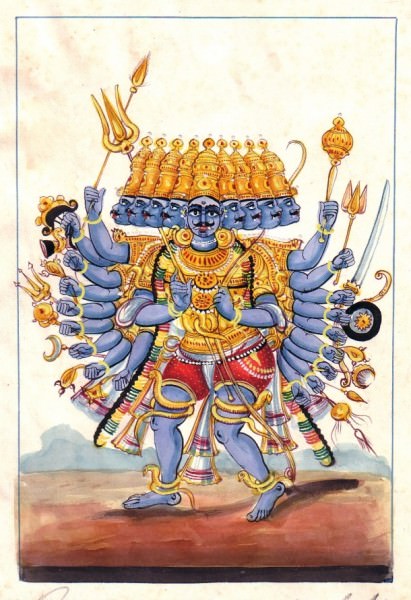
Ravana the Demon King
Surpanakha flew towards Lanka (modern Sri Lanka), ruled by her brother Ravana, and complained. Enraged, Ravana vowed vengeance. He persuaded the demon Marich to disguise himself as a golden deer and wander near Rama's hut. When Sita saw the golden deer, she begged Rama to get it for her. When the brothers were out pursuing the deer, Ravana arrived, abducted Sita, placed her in his flying chariot, and flew through the skies to Lanka. When the princes, after having killed the golden deer and discovered it was a demon in disguise, returned to their hut, they found it empty and started to look for Sita.
RAMA MEETS HANUMAN
During their wanderings, the princes came upon a group of monkeys who showed them some ornaments of Sita's: the monkeys had seen a beautiful lady crying and dropping her ornaments from a chariot in the sky that was being driven southwards by a demon.
Among the monkeys was Hanuman, who ultimately located Sita's whereabouts to be in Ravana's kingdom in Lanka. Rama gained the help of the monkey chief Sugreeva, gathered a monkey army, marched southwards, built a bridge across the ocean and crossed over to Lanka. Rama, after an epic battle, was then able to kill Ravana and finally free Sita.

Hanuman
SITA FACES A TRIAL BY FIRE
When Sita walked up to Rama, however, he refused to accept her since she had been a living in a demon's palace all this while. Hurt, Sita entered into a burning pyre intending to give up her life. However, Agni rose from the flames, carrying an unhurt Sita in his arms and said:
एषा ते राम वैदेही पापमस्यां न विद्यते
Here, Rama, is your Sita. She has not an iota of sin in her. ( Valmiki Ramayana, 6.118)
This event came to be known as the Agni Pareeksha ( agni = fire, pareeksha = test).
RAMA IS CROWNED AT AYODHYA
Since the 14 years were over by now, Rama then returned to Ayodhya, was crowned king, and ruled the kingdom with great wisdom: no child died before their parents did, no door needed locks against robbers, no farmland lay barren, no tree went fruitless, and there was peace and prosperity all around.
SITA IS BANISHED
The Ramayana, as composed by Valmiki, is thought to have six chapters and to end at this happy point. A seventh chapter, called the Uttar-Ramayana ( uttar = post, after, that which comes later) continues the story and ends on a slightly less happy note. This is how the story continues: After many months of Rama's rule, rumours began to surface among the populace regarding Sita's chastity since she had been abducted and imprisoned by a demon. Mindful of the feelings of his subjects, Rama asked Sita to undergo an Agni Pareeskha again. Sita refused, whereupon Rama banished her. Lakshman was deputed to escort her out of the kingdom; he did so unwillingly and left Sita near the hermitage of Valmiki.
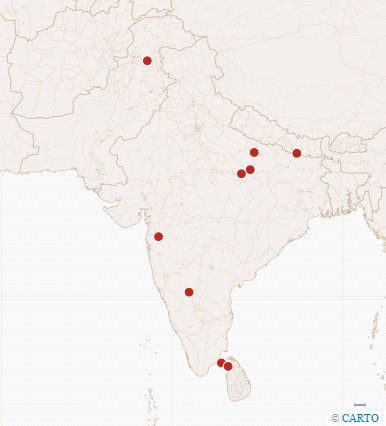
Ramayana: Places
LAVA & KUSH SING THE RAMAYANA
Sita was pregnant at that time. Valmiki took her in as an ashram inmate, and she gave birth to her twins there: sons named Lava and Kush whom Valmiki brought up with great love and affection, teaching them princely skills such as archery as well as scholarly skills such as the Vedas and other scriptures. Valmiki also taught them to sing the Ramayana, which he had finished composing by this time. The twins, who were unaware of their parentage and, hence, unaware that they were singing about their own family, would recite the poem at gatherings. They became so well-loved for their sweet recitation that their fame reached Rama's ears who summoned them for a performance. It was here at Rama's court that the true story was revealed to the twins: that they, spitting images of the king, were his sons and that their mother was none other than the Sita whom they sang of.
Rama, in remorse, asked Sita to return to the palace if she could prove her chastity again before an assembly. Sita, in anguish, cried out, "O mother earth, just take me away from this place forever!" Whereupon the ground parted, the goddess Prithivi arose on a golden throne, took Sita in her lap, descended, and the rift closed. Sita was forever lost. Griefstricken, Rama decided to live no longer. He abdicated the throne in favour of his sons and, along with his brothers, entered the waters of the river Sarayu that skirted Ayodhya; their spirits left their bodies and ascended to the heavens.
REGIONAL VARIATIONS
The Ramayana was composed in Sanskrit. Over the years of re-tellings, several vernacular versions emerged that embellished the story, added regional touches, and inserted explanations and justifications for those bits that showed the hero, Rama, in a not-too-heroic light. The Ramavataram, composed by the Tamil poet Kamban in the 12th century CE, is popular in the southern parts of India. In the north, the Ramacharit Manas, composed by the Awadhi poet Tulsidas, is extremely popular. Other variations exist in Bengali, Malayalam, Telegu, Kannada, and other Indian languages.

Staircase of the Kailasa Temple, Ellora
LEGACY
The Ramayana 's characters have found their way into the common speech and idiom of the land. Public recitations of the Ramayana are common. The epic has been adapted into plays and films; it is also enacted every year by local troupes and neighbourhood societies in North India during the Dusshera festivities of the present times. Scenes from the epic can be seen on the walls of some of the oldest temples across Asia.
Rama is worshipped as an incarnation of god Vishnu, and it is not uncommon to find a Rama temple in almost every other neighbourhood in the country in the northern parts of India, especially in the Gangetic belt. In countries of South-East Asia, such as Cambodia, Indonesia, and Malaysia, the story of Rama continues to be told through intricately crafted shadow puppet shows.
Pandavas › Who Was
Definition and Origins
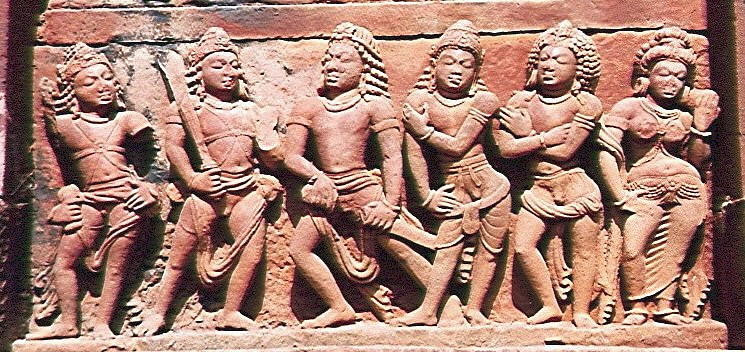
Pandavas were the five powerful and skilled sons of Pandu, the King of Hastinapur and his two wives Kunti and Madri.Hastinapur is equated with the current modern Indian state of Haryana, south of New Delhi. The Pandavas - Yudhistira, Bhima, Arjuna, Nakula, and Sahadeva - are the central characters in the most applauded epic in Hinduism, the Mahabharata. The brothers were famously involved in the Kurukshetra War with their cousins the Kauravas over who would control the throne of Hastinapur, and were, ultimately, victorious.
The birth of the Pandavas is supposedly traced back to 3229 BCE when Yudhistira was born, and to 3226 BCE when Nakula and Sahadeva were born. The most engaging story of the Pandavas can never be dissociated from the formation of social structures and political decisions of current India, due to the influence it has had in the way of functioning and inheriting the values of Dharma established during their reign. The story of the Pandavas influences many cultures, especially of India, in the way many Hindu households makes decisions, assess and implement the moral conclusions of their actions.
BIRTH OF THE PANDAVAS
The story of their birth is rather interesting and beyond the general notions of belief. Pandu had two wives, Kunti and Madri. A king was legally allowed to have multiple wives in those times. Interestingly, while hunting in the forest of Hastinapur, Pandu happened to hit with an arrow a copulating deer couple, who were in fact humans disguised as deer in order to enjoy making love in the open. The male deer was Rishi Kidamba who, having being pierced by the arrow, cast a curse on Pandu that he would die the moment he advanced to be intimate with a women. This seriously affected the two wives who were then not able to bear a biological child of their own through Pandu. Pandu then renounced his kingdom and lived in the forest as an ascetic, after giving the throne to his cousin/brother Dhritarashtra, the father of the 100 Kauravas, with whom the Pandavas would wage a war later.
ALL FIVE PANDAVAS INHERITED DIVINE QUALITIES FROM THEIR CELESTIAL FATHERS.
Surprisingly, Kunti had received a boon in her early adulthood from a fierce and renowned Rishi Durvasa that she could call any of the divine Gods and bear a child. This proved to be very useful and, through the use of mantras given to her by Durvasa, Kunti called upon Yama, the God of Death and Dharma, through whom she gave birth to Yudhistira. She then invoked the Wind God, Vayu, through whom she brought Bhima to the world, later she called Indra, who gave her Arjuna as another Pandava. She then felt pity for Madri, who would otherwise have no child if she did not help her, so with the help of the mantras Madri called upon the twin Ashvins, who bore her Nakula and Sahadeva. Thus, the five Pandavas were born through the combined grace of the curse on Pandu, the boon to Kunti, and the coming of the Gods who helped the two wives bear five children. All the Pandavas inherited divine qualities from their celestial fathers.
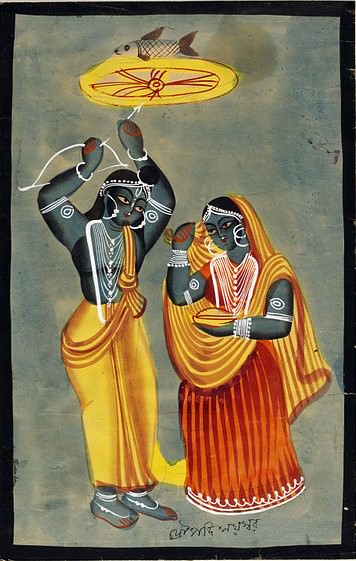
Arjuna wins Draupadi
CONTEST FOR DRAUPADI
The Pandavas were human in nature but had divine qualities which they nurtured and built with the help of their preceptor Guru Drona, a Brahmin Rishi, who was the head teacher of all their education, along with those of the 100 Kauravas, the cousins of the Pandavas. Lord Krishna, who was the son of Kunti's brother, plays an equally central role in supporting the Pandavas during their exile imposed cunningly by the Kauravas. During the Pandavas exile, the King of Drupada organised a contest, called Swayamvar, where his daughter, Draupadi, would marry the one who won the contest. The contest was to hit the eye of the circularly rotating fish in the sky - an imaginary construction - with a bow and string, by looking down on the image of the fish in a water pond below. To add a surprise, there was a sixth Pandava, Karna, who had been born when Kunti, while being single, had called the Sun God Surya to test the mantra, who gave her this magnanimous son. But being single and to save her identity from being maligned, Kunti reluctantly had to abandon Karna who was picked up by a childless couple who worked as a charioteer in Hastinapur. Karna was unmatchable in vigour, knowledge, deeds, charity, and skills of all kinds.Arjuna was the only match for him. Karna too turned up at the contest, but having been denied entry by Draupadi for being a son of unknown parents and a son of a charioteer, Arjuna was the only one to accomplish the feat and win the contest.
YUDHISTIRA
Yudhistira's name indicates steadfastness at all times, even at war when things are most difficult. As he was the son of Yama, he was the most righteous and steadfast, a follower of Dharma in all walks of life, and shining like the brilliant sun in the knowledge of law, ethics, and morality. He was the most righteous of the brothers never having spoken a lie in his life, except during the final war where he was made to suppress the loud truth through neutrality. He was such a steadfast man of righteous deeds that his chariot while moving would remain a few inches above the ground. Unfortunately, due to this fondness for righteousness, he was duped during a game of dice with the Kauravas to gamble his wife Draupadi and lost her.His deeds are enormous and he is the only one of two examples (the other is Lord Rama ) off the practice of righteousness in all modes and conditions of life, even if that meant killing oneself.
BHIMA
Bhima was the son of the Wind God Vayu, indicating the fierce force and braveness that he inherited. He was the mightiest of the brothers, both in physical prowess and in skill and speed. He was fond of eating and often took the lion's share of the shared meals of the Pandavas. He was fond of cooking, was a great cook and employed himself as a chief cook in the last year of the Pandavas exile where they were to supress their identity and live unknown to the world. He was the one who took an oath to kill the 100 Kauravas as a result of losing the game of dice and watching helplessly their only wife, Draupadi, getting disrobed by Dushashana, younger brother of Duryodhana.
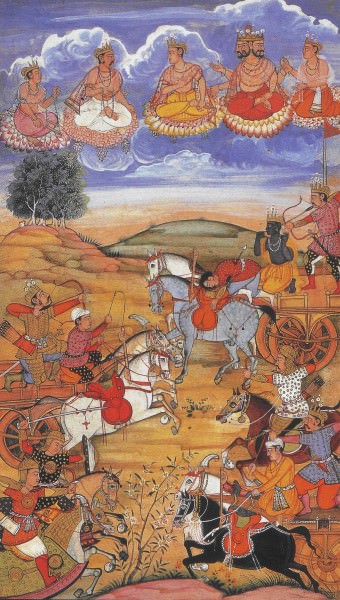
Arjuna During the Battle of Kurukshetra
ARJUNA
Arjuna was the mightiest in skills, matchless in knowlegde, skills, and saintly temper, possessed of divine weapons, and the major responsibility of winning the Kurukshetra war was given to him, as he had Lord Krishna as his charioteer and adviser.His divine weapons, when used, vanquished even the most renowned and skilled warrior. He was the best pal of Lord Krishna, and the recipient of the divine knowledge from Krishna, often called the Bhagavad Gita. During their exile, he endured the most severe austerities and sacrifices and pleased Lord Shiva to appear, who willingly presented him with a divine weapon for his war.
NAKULA
Nakula, being the son of the Ashvins, was the most skilled with animals, especially horses and elephants. He was compared to the Lord of Love (Cupid) Kamadeva as he looked beautiful and a woman-charmer. He was steadfast in his conduct, had superior knowledge of health and cures for many of life's threatening diseases. He, along with Sahadeva, saved Karna's life during the war on Kunti's request, when Karna donated his chest weapon to Indra, Arjuna's father in an act of charity. He was an excellent sword fighter, equipped with the best of knowledge pertaining to sciences, warfare, and unusual weapons.
SAHADEVA
Sahadeva was the second son of the Ashvins and Madri, and he was the wisest and most mysterious character of the Pandavas. Pandu, while on his deathbed, requested him to eat his flesh so that he could get all his knowledge, and thus Sahadeva was then able to foresee the future with diminished clarity and saved the Pandavas lives on many occasions. He was the best in cattle prevention and their growth, was a great sword fighter like Nakula, and had acquired all requisite knowledge of Dharma and righteousness.
KARNA
Karna was the eldest of the Pandava brothers and the sixth Pandava, discovered only at his deathbed in the war by his younger brothers. He was matchless in skill, weapons, charity, and could remain undefeated even by the gods. He took his training from Lord Parasurama, a fierce Brahmin and the sixth incarnation of Lord Vishnu. Karna was the son of the Sun God and likewise was most brilliant and outstanding, both in knowledge and warfare. He was the only one who could see through the Sun for hours without disturbance, being his son. He could have been undefeated in the war, but only the cunning advice of Lord Krishna to Arjuna to kill him while being disarmed brought his life to an end. Throughout his life, he was called a Suta putra or a child with unknown parents, and Radha adopted him when he grew up. He was incomparable in charity and once also gave his entire palace away to be burned down to help the citizens of his kingdom. Such was his merit that his power to giveaway never vanished and prosperity never left him.
LICENSE:
Article based on information obtained from these sources:with permission from the Website Ancient History Encyclopedia
Content is available under License Creative Commons: Attribution-NonCommercial-ShareAlike 3.0 Unported. CC-BY-NC-SA License